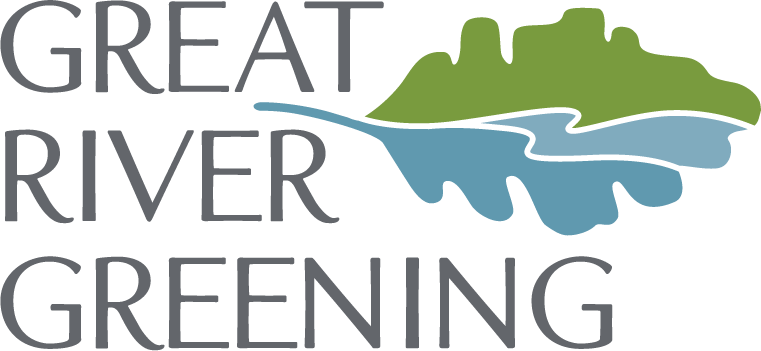Stewardship Spotlight: Frogtown Green—Greening the Neighborhood One Tree at a Time
04/17/2024 – Frogtown Neighborhood, Saint Paul, MN.
Here at Great River Greening we build strong, community-based partnerships, from our staff and Board of Directors to volunteer groups, donors, municipalities, vendors, schools, and the State of Minnesota. Minnesota’s land and water are shared natural systems, and we rely on the support of individuals and groups to protect them.
Today we’re shining the spotlight on our partner Frogtown Green, a small but mighty neighborhood group focused on nurturing green space in the Frogtown neighborhood of Saint Paul. Powered by enthusiastic volunteers, the organization manages community gardens, gives away trees, plants and maintains pollinator habitat, and sponsors events showcasing environmental stewardship.
Frogtown Green sprang from an effort by a small group of residents, supported by the Trust for Public Land, to transform 13 acres of vacant land into a city park and urban farm. Frogtown Park and Farm opened in 2012, creating a cherished oasis in a neighborhood with sparse greenery compared with less diverse, wealthier neighborhoods in Saint Paul. According to the Metropolitan Council’s Growing Shade tool, trees cover only 22 percent of Frogtown compared to the citywide average of 31 percent.
From that modest beginning Frogtown Green—which doesn’t manage Frogtown Farm—has grown into a champion of environmental equity and sustainability in the neighborhood. At its core is the idea that a shared love of the natural environment can unite residents from varied cultural backgrounds and with disparate financial means. “You make connections with your neighbors by creating something together—planting trees, saving pollinators, establishing community gardens where people can grow their own food,” said Frogtown Green founder and co-director Patricia Ohmans.
Last year more than 60 Frogtown community members harvested produce from the Lily Pad and Our Village community gardens. Once vacant lots have become community gathering spots; on August 17 the Lily Pad will host Frogtown Green’s fourth annual Climate Carnival—a celebration of environmental sustainability with exhibits, games, prizes, and free food. Frogtown Green also offers nature education workshops for children held after school at community recreation centers and other locations in the neighborhood.
Increasing Frogtown’s tree canopy is a key objective; since 2011 the organization has donated and helped to plant over 1,000 shade and fruit trees in Frogtown and the adjacent Summit-University neighborhood. Other initiatives include the Bee Line, plots of native flowers planted along Pierce Butler Route on the north end of the neighborhood; and a “mini-forest” of more than 900 native trees that will take root this spring at Our Village. “It’ll be pretty cool,” said Chris Stevens, Frogtown Green’s co-director. “It’s right on Pierce Butler; people driving by will be able to see this patch of dense trees bordering the garden.”
Frogtown Green relies on grants, donations, and in-kind contributions to fund its work. Great River Greening has pitched in by coordinating restoration events in the neighborhood—last year volunteers removed invasive buckthorn and planted native prairie grasses and wildflowers in Frogtown Park—and supplying trees. This year Frogtown Green plans to plant 350 trees in Frogtown and parts of Summit-University. About 200 of those trees will be purchased by Great River Greening with federal grant funds designated for communities identified as in need of tree canopy improvement via the Climate and Economic Justice Screening Tool (CEJST).
Frogtown Green’s work is far from done. Among its goals are the following:
Ensuring that no resident need walk more than 10 minutes to access public green space;
Partnering on projects with other local nonprofits (Xiem Vuong, who started at Frogtown Green as a community gardener, heads up its outreach efforts); and
Planting thousands more trees in parks and backyards to blunt the impact of climate change on the neighborhood. Stevens notes that Frogtown Green is on pace to plant another 1,000 trees in the next five years. As those trees grow taller, they will bring the community’s tree canopy that much closer to equity with the coverage enjoyed by more affluent neighborhoods.
“Frogtown Green has been planting trees in the neighborhood for going on 10 or 12 years,” he said. “Today those trees we planted in the beginning are decent-sized trees, casting shade.”
Photo Credits:
Xiem Vuong, Chris Stevens, and Patricia Ohmans in Frogtown Park (Phil Davies);
Community members visit a booth at the Frogtown Green Climate Carnival (Phil Davies);
Volunteers planting pollinator-friendly flowers, shrubs, and woodland plants in place of previously removed buckthorn at Frogtown Park (Phil Davies);
Frogtown Green and Great River Greening staff and volunteers team up to plant trees in the Frogtown neighborhood (Phil Davies).




